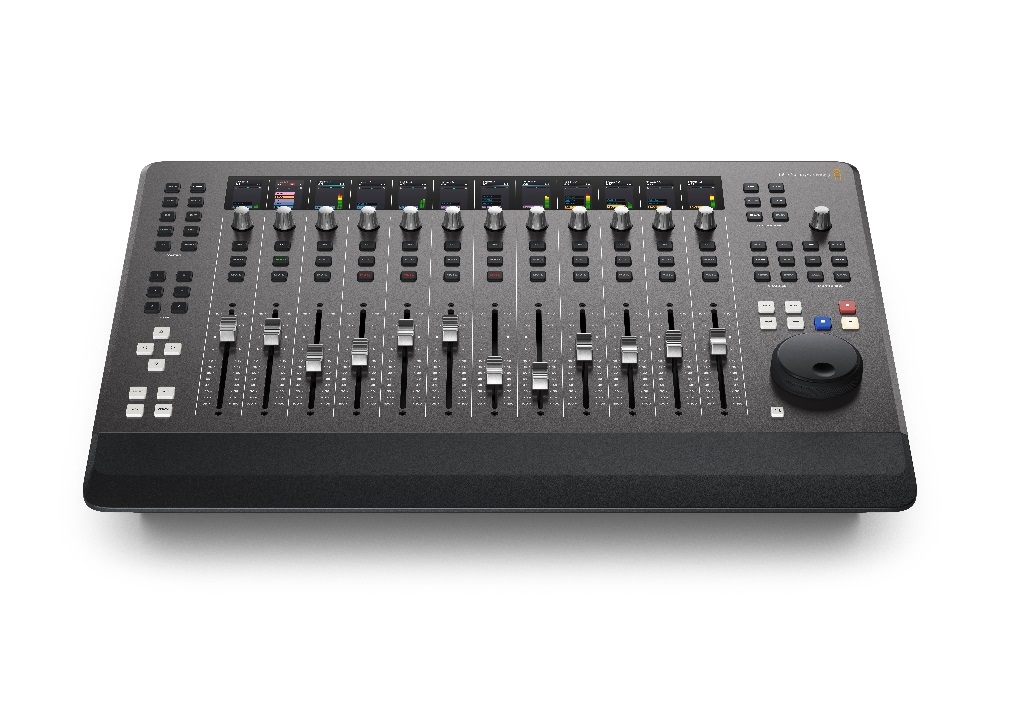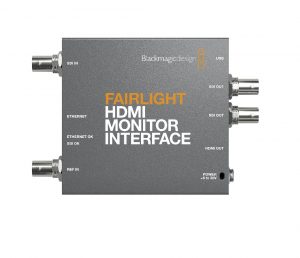Description
The Blackmagic Design Fairlight Desktop Console, a portable audio control surface featuring 12 incredibly high quality touch sensitive flying faders, built in LCDs above each channel strip for pan and effects control, and full automation control. The Fairlight Desktop Console also features an innovative HDMI interface for connecting a monitor to view an expanded graphical interface with audio status and metering.
The Fairlight Desktop Console is a complete audio mixing control surface for mixing multiple tracks at once, automating a variety of parameters and plug-in settings, controlling channel functions, recording, monitoring, and navigating their project. It’s ideal for new users, smaller studios, commercials, online and independent work. Customers get a familiar mixer design with 12 motorized faders, precision control knobs and illuminated buttons for quickly identifying channels. Customers can use the knobs and buttons to control channel parameters, EQ, dynamics, plug-ins and more. The built in HDMI output lets customers connect a display, giving customers the same interactive graphical feedback as the larger consoles.
The Fairlight Desktop Console uses the same high quality faders as the full size modular studio consoles. The sculpted faders are smooth and provide the perfect amount of resistance for making subtle adjustments. The precision engineered encoder knobs ensure a long life of noiseless operation, and the console buttons are rated at a million presses. Individual LCDs display track information for each channel. The high quality search dial is extremely responsive and is much faster than a mouse. The soft front panel bumper makes long sessions more comfortable, the console can be installed flush in a custom desk, and there’s even a built in power supply, which means no power brick.
The Fairlight Desktop Console features 12 channel strips that can be used in a variety of ways for mixing audio. Each channel strip has a motorized fader for adjusting levels, a series of buttons for solo, mute and other parameters, a multifunction pan knob, and an LCD that shows customers information about the channel or track on which customers are working. Channel strips can be used to control an individual track and any strip can be assigned to any track in the project. Customers can also use a single strip to control multiple tracks in a group, or customers can use the channel strips to control buses. This gives customers the speed and flexibility customers need for total control over their recording and mixing sessions.
When users are working on a tight deadline and have a large project with a lot of tracks, customers don’t want to waste time scrolling through the timeline or hunting for a clip. The Fairlight Desktop Console helps customers work faster because it includes transport buttons and a high quality jog shuttle wheel. That means users will be able to quickly move around the timeline and navigate clips, scrub, start or stop playback, or jump to a new position with incredible speed. The controls are logically grouped, allowing customers to keep their hand in one position while navigating the timeline from end to end, or anywhere in between, in seconds. The search dial can also be used for timeline zooming, clip levels and more.
Control function selector buttons let customers assign the buttons and knobs on the panel for different purposes. Customers can quickly select between master and channel controls, panning, plug-in control, EQ, dynamics and more. By default, the console works in strip mode, giving customers one channel strip per track. Focus mode lets customers assign all of the select buttons and knobs on the console to work on the parameters or plug-ins for a single track. That means customers can adjust the EQ, dynamics or any other plug-in parameter for a track using all of the select buttons and knobs on the console. For example, customers can adjust multiple frequency ranges in the EQ at the same time, which is impossible to do with a mouse.
Fairlight’s powerful automation lets customers record parameter changes customers make over time. For example, customers can record level changes as customers move the faders on the console. Fader adjustments are saved and can be edited later. Fairlight lets customers automate anything from simple level changes to complex plug-in, EQ and dynamics changes. That means customers can use the console to create and save live adjustments.
The faders and knobs are touch sensitive, activating the moment customers touch them, so customers don’t have to move them for the console to know customers want to work on that parameter. Six automation buttons enable and disable automation, set recording method, and which automation curves show in the timeline tracks.
The monitoring controls on the Fairlight Desktop Console let customers quickly switch between sources, control both their studio and booth levels, or even control talkback if customers have a Fairlight Audio Interface installed with their computer. Customers also get a level knob along with buttons for dimming and muting their speakers, allowing customers to instantly cut or reduce the sound so customers can have a conversation in their studio or suite.
For direct visual feedback customers can add an HDMI display to the Fairlight Desktop Console. This allows customers to see an extensive graphical display of everything happening on the console. Customers will be able to see channel strip information, levels, equalization, dynamics processing, plug-in interfaces and more. That means customers don’t have to open pop-up windows on top of their timeline. For example, when customers adjust EQ settings, its interface will be displayed on the screen as customers turn the knob. The screen automatically switches to show customers buses, inline channel strip controls or single channel controls when in focus mode. There’s no configuration needed, simply plug in an HDMI monitor and start working.
“This is an extremely exciting product because it gives us a high quality audio control surface that’s much better than using a mouse and keyboard, but it’s not as expensive as a full 2 bay studio console, which was previously our entry level point for Fairlight hardware,” said Grant Petty, Blackmagic Design CEO. “Plus it’s also incredibly high quality with the same flying faders as the large Fairlight studio consoles, so we have not reduced quality as many other affordable consoles do. A good example of the quality of the new Fairlight Desktop Console is the HDMI video output, which means customers get the same audio channel status and powerful metering which the Fairlight studio consoles have, simply by plugging in an HD TV!”

